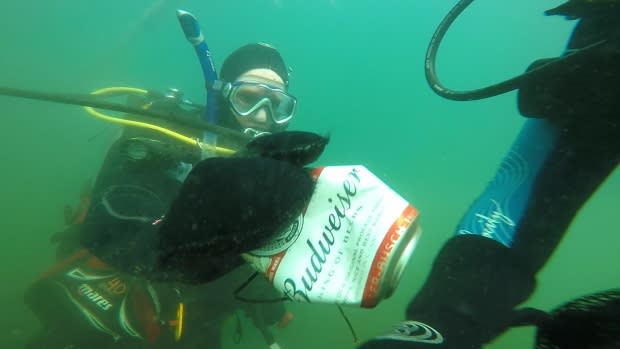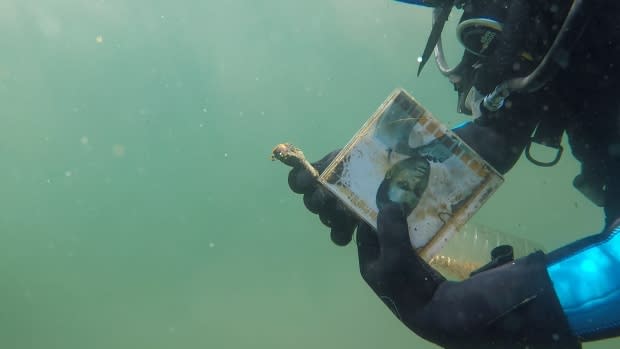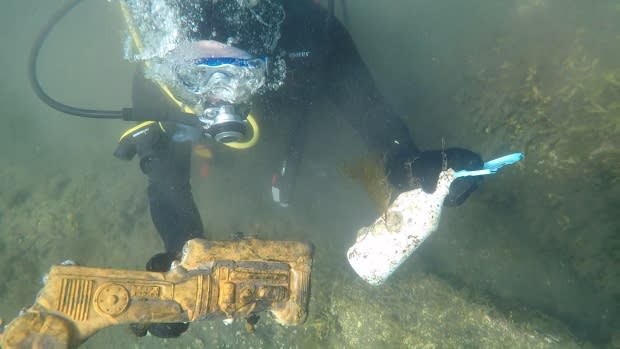A deep dive into the plastic woes facing Canada's coasts and the world
Waves of Change is a CBC series exploring the single-use plastic we're discarding, and why we need to clean up our act. You can be part of the community discussion by joining our Facebook group.
When Geneviève Philibert et Alexandre Normandeau go diving, they take an unusual item with them — a mesh bag.
The pair have been diving for pleasure for about a year in the Halifax area and they take the net with them to scoop up the abundant waste they find at the bottom of the ocean.
"Essentially, bottles, fabrics, pieces of plastic, caps, cans, things like that," said Philibert.
To help show Radio-Canada the extent of the problem, we joined the couple as they dove from a wharf in Lower Prospect, which is about 30 kilometres outside of Halifax. We're there to catalog how much waste can be found at the bottom of the ocean during a 45-minute dive.
"I want to see fish, algae, I don't want to see too much garbage," said Philibert. "Close to a port like that, a wharf, there will likely be a lot of it."
We come up with a diving plan and jump in the water. Armed with a sack to store what we find, we quickly spot many cans, bottles and pieces of plastic as we near the bottom.

It's important not to touch the muddy bottom of the ocean because disturbing the sediment will reduce your visibility.
We collect so much waste that we have to go back to the surface of the water to unload, before descending again.
When we go back in, other surprises wait for us — a CD, garden hose, child's toy, sweater — all things you wouldn't expect to find in the water.
In less than an hour, we collected dozens of objects that would otherwise have remained at the bottom of the ocean.
Normandeau, a marine biologist, can't help but think about how far waste can travel in oceans.

"Plastic can float along the coastline and beaches and then sink to the bottom of the ocean, as far as 2,000 or even 3,000 metres by underwater avalanches," he said.
Worried about the state of their favourite diving destinations and the negative impact plastics have on the ecosystem, Philibert was hoping for clear commitments on protecting the oceans when the G7 ministers met in Halifax last week.
At that meeting, companies including Unilever Canada, IKEA Canada and Coca-Cola pledged their support Thursday for the Ocean Plastic Charter, promising to reduce their use of plastics and avoid waste.
Catherine McKenna, Canada's environment and climate change minister, also announced that the federal government is aiming to eliminate single-use plastics from their operations.

"If our laws and rules were stricter, by banning those products and moving toward using more durable, reusable products, I think that would be a good step," said Philibert.
The statistics are dizzying. According to the Canadian government, eight million tonnes of plastic each year end up in the world's oceans. By 2050, there might be more plastic in the water than fish.
At this spring's G7 summit in Charlevoix, Que., Canada, France, Germany, Italy and the United Kingdom agreed to use 55 per cent less plastic packaging by 2030. They also aim to recover all plastics by 2040.

The U.S. and Japan were the only G7 countries not to sign the agreement.
For the G7 ministers meeting in Halifax last week, taking action on plastics was pressing because the effects on the environment are even more harmful than previously believed.
Last month, Sarah-Jeanne Royer, a researcher at the University of Hawaii, showed for the first time that degrading plastic waste is a cause of greenhouse gases.

"Once they're exposed to ultraviolet light, they start to produce greenhouse gases," she said. "So, as plastics get buried in the ground or the depths of the ocean, they will continue to produce greenhouse gases," she said.
Royer said another reason for removing plastics from the ocean is that when they're left there, they break down into tiny pieces known as microplastics, which elevates the greenhouse gas effect because there's more surface area for the ultraviolet light to reach.
The Canadian Plastics Industry Association recently set a goal that by 2030 all plastic packaging be recyclable or recoverable.
Catherine McKenna, the federal environment minister, invited plastic producers to last week's G7 meeting.
Much like Philibert, Royer would like to see the federal government go further and adopt a law that bans single-use plastics.
"The plastics industry needs to work with us to find better solutions because in the next 30 to 40 years, we won't be able to manage larger amounts of plastic," she said.

